We tested and reviewed the top water filter systems that offer PFAs removal. Here are 6 models we found to be the most effective in tackling forever chemicals.
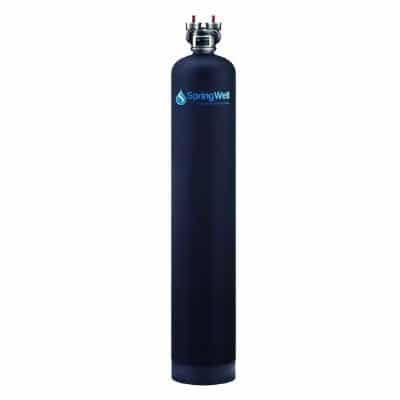
SpringWell CF Whole House Filter
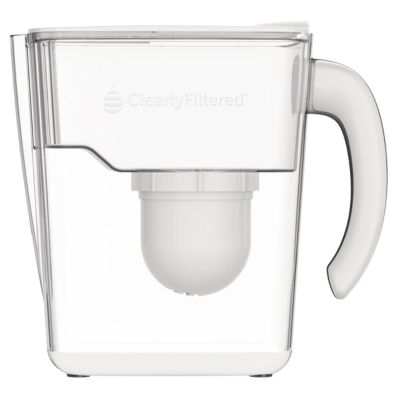
Clearly Filtered Water Filter Pitcher
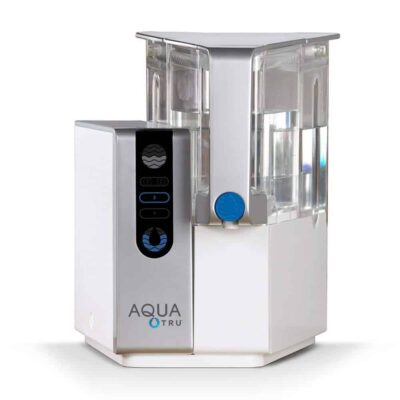
AquaTru Countertop RO
The water filtration market is teeming with a dizzying number of options, with something for every budget and use case. But not all water filters are guaranteed to remove toxic PFAS, a particularly dangerous group of “forever chemicals” that have several deadly health effects, including cancer.
If you’re determined to remove PFAS from your drinking water but you don’t know where to start, you’ve come to the right place. We’ve tried and tested over a dozen water filters in our own home in Colorado. Our top picks consist of products from well-established manufacturers, like SpringWell and Aquasana, as well as some newer brands that have taken the industry by a storm in the last 5-10 years, like Clearly Filtered. We’ve shared our top shortlisted filters for removing PFAS based on their % removal of this contaminant and other common impurities, filtration speed, durability and reliability, and overall value for money.
Table of Contents
🥇 Best PFAs Water Filter
- Best Whole House Filter: SpringWell CF
- #1 Pitcher: Clearly Filtered Water Pitcher
- Great Countertop System: AquaTru Countertop RO
- Best Under-Sink Filter: Aquasana AQ-5300
- Best for Refrigerators: Clearly Filtered Universal Inline Fridge Filter
- Gravity-Fed Countertop Option: ProOne Big+ Gravity-Fed Water Filter
📊 Comparison Chart of PFAs Water Filters
| Product |  SpringWell CF |  Clearly Filtered Pitcher |  AquaTru Countertop RO | 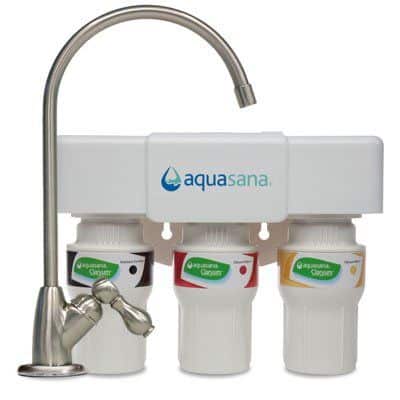 Aquasana AQ-5300 |  Clearly Filtered Universal Inline Fridge Filter | 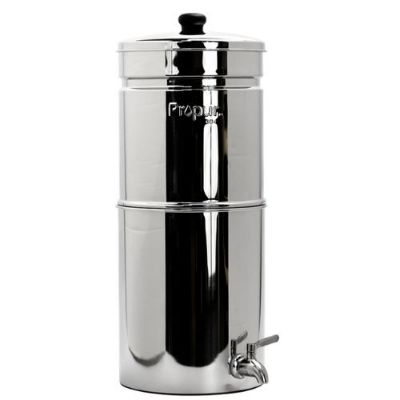 ProOne Big+ |
|---|---|---|---|---|---|---|
| Ratings | 5/5 | 5/5 | 4.5/5 | 4.5/5 | 4.5/5 | 4.5/5 |
| Ranking | 1st | 2nd | 3rd | 4th | 5th | 6th |
| Price | $1016.44+ | $90.00 | $449.00+ | $164.99 | $165 | 229.95+ |
| PFAs Reduction | 99% | 99.8% | 99.9% | 96% | 99.8% | 99.9% |
| Contaminants Reduced | 10+ | 365+ | 83+ | 77+ | 232+ | 200+ |
| Certifications or Testing | – | NSF 42, 53, 401 & 473 | NSF 42, 53, 58, 401 & P473 | NSF 42, 53 & 401 | NSF 42, 53, 401 | NSF 42, 53, P231 |
| Filter Life | 1,000,000 gallons | 100 gallons | 600 – 1,200 gallons | 600 gallons | 365 gallons | 1,000-1,200 gallons |
| Annual Cost | ~$40 | ~$140 | ~$80 | ~$130 | – | ~$100 |
| Warranty | Lifetime | Lifetime | 1 year | 180 days | Lifetime | 1 year |
⭐ Reviews – Top PFAs Filters 2025

SpringWell CF
The SpringWell CF is our top pick as the best whole home water filter that effectively tackles PFAS in contaminated drinking water, using highly capable KDF and catalytic carbon media to remove virtually all PFOA and PFOS from your entire water supply.
Specs
| Price | $1016.44+ |
| PFAs Removal | 99% |
| Contaminants Removed | 10+ |
| Certifications or Testing | – |
| Filter Life | 1,000,000 gallons |
| Annual Cost | ~$40 |
| Warranty | Lifetime |
We tested the SpringWell CF on our whole-home water supply in Colorado, and this system made us feel better protected against PFAS than any other system we tried, for one key reason: it’s a point-of-entry unit, so it removed these chemicals from the water in our entire home’s plumbing system. That means all our faucets, appliances, and fixtures, were supplied with PFOA and PFOS-free water.
| Upgrades | Price | Uses |
|---|---|---|
| UV Water Purification System | $1100.99 | Boil water advisory protection |
| Reverse Osmosis Water Filter System | $442.23 | Drinking water |
| Easy Installation Kit (Single Tank) | $157.49 | Clack connectors add-on |
With a starting price of $1,016 (for the smallest CF1 1-3 bathroom system), the SpringWell CF is costlier than most of the smaller point-of-use systems we tested, which makes sense given its installation location. Plus, the filter media in the tank has a 1-million-gallon capacity, so our only maintenance task was replacing the sediment pre-filter every 6-9 months, reducing our annual maintenance spend to less than $40.
| SpringWell CF Configurations | Price |
|---|---|
| CF1: 1-3 Bathrooms | $1016.44 |
| CF4: 4-6 Bathrooms | $1199.66 |
| CF+: 7+ Bathrooms | $1737.20 |
Best For:
Anyone looking to invest in one of the best value-for-money whole house systems, offered by one of the most trusted brands, that can virtually eliminate forever chemicals in water supplying your entire home.
What We Like:
- Removes PFAS from all water in your home, rather than one fixed location
- Also removes other common tap water impurities
- Long-lasting media reduces annual maintenance spend
- Available in multiple sizes & flow rates
What We Don’t Like:
- Difficult to DIY install – may need to pay for professional installation
- Not certified for performance

Removes PFAS From a Whole House Water Supply
The SpringWell CF should be installed as close as possible to your main water pipe’s entry point into your home, upstream of the hot water heater, so both your hot and cold water are filtered. Given the challenging nature of the installation, and the potential for whole-house water disruption if we did something wrong, we paid for a professional plumber to install the unit for us. Make sure to factor in this extra cost when you’re deciding whether to buy the system.
Despite the higher upfront cost and our extra spend on a professional install, the SpringWell CF felt particularly reassuring to use and had a major advantage over POU systems: it could remove PFOS and PFOA from the water flowing through our entire home. That meant we could avoid drinking, showering and bathing in, cooking with, and washing our clothes and dishes in, water containing these chemicals. We’d personally prefer to reduce our exposure to PFAS in all areas of our water usage, and the SpringWell CF ticked our boxes in this respect.
Proven To Reduce Common Tap Water Contaminants
We were able to conduct a laboratory test on our municipal drinking water in Arvada, Colorado, which proved the SpringWell CF’s ability to remove the common contaminants present in our water supply. Quick disclaimer: our water supply didn’t contain PFAS, so we weren’t able to test how the system could remove forever chemicals specifically. We plan to test a water supply that contains PFAS in the future, and we’ll add these findings to this review when we have.
In our testing, we found that the CF could remove 100% of cobalt, nickel, and molybdenum (three heavy metals), as well as 100% of bromodichloromethane, trihalomethane, and chloroform (disinfection byproducts).
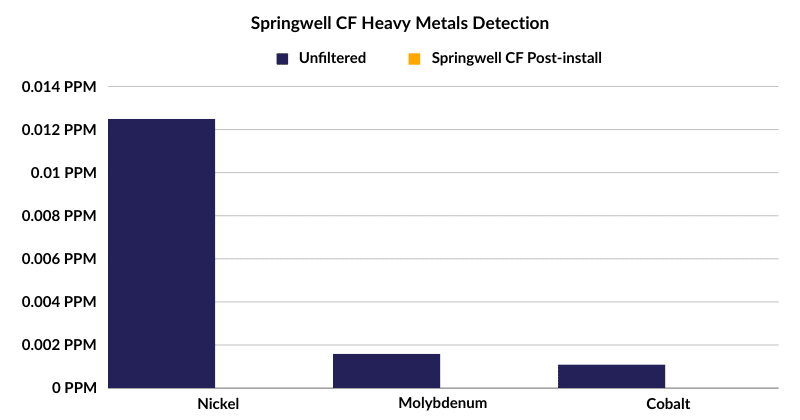
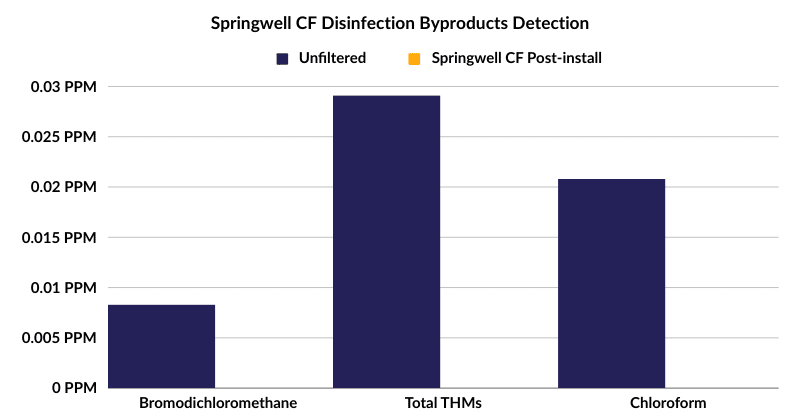
Other contaminants reduced included lead (96%), copper (76%), and fluoride (17%), as well as manganese, barium, zinc, and strontium.

The CF is a tank-based system that combines two filtration media – catalytic carbon filter media and KDF-55 media. Catalytic carbon is a known effective filtration solution for PFAS, removing up to 97% of these chemicals. Our only disappointment is that the CF doesn’t have an official certification for its contaminant removal abilities, and we couldn’t find third-party test results to support the manufacturer’s performance claims.
Take a look at our laboratory test results for the SpringWell CF below:
| Contaminant | Measurement | Pre-Filtration | Post-Filtration | % Change |
|---|---|---|---|---|
| Barium | PPM | 0.0267 | 0.0158 | -41% |
| Bromodichloromethane | PPB | 0.00832 | 0 | -100% |
| Chloroform | PPB | 0.0208 | 0 | -100% |
| Cobalt | PPM | 0.0011 | 0 | -100% |
| Copper | PPM | 0.222 | 0.0532 | -76% |
| Fluoride | PPM | 0.6 | 0.5 | -17% |
| Lead | PPM | 0.0182 | 0.0007 | -96% |
| Manganese | PPM | 0.002 | 0.0013 | -35% |
| Molybdenum | PPM | 0.0016 | 0 | -100% |
| Nickel | PPM | 0.0125 | 0 | -100% |
| Strontium | PPM | 0.125 | 0.09 | -28% |
| Sulfate | PPM | 36 | 27.2 | -24% |
| Total THMs | PPB | 0.02912 | 0 | -100% |
| Zinc | PPM | 0.917 | 0.255 | -72% |
Read the Full Review: SpringWell CF Whole House System Review

Clearly Filtered Water Pitcher
In our opinion, the Clearly Filtered Water Pitcher is the best water pitcher filter for removing PFAS. It has an official WQA certification for PFAS removal and has been third-party tested to remove more contaminants than any other water filter pitcher available today (365+ in total), including up to 99.5% PFAS – one of the most impressive figures for PFAS reduction that exists today.
Specs
| Price | $90.00 |
| PFAs Reduction | 99.8% |
| Contaminants Reduced | 365+ |
| Certifications or Testing | NSF 42, 53, 401 & 473 |
| Filter Life | 100 gallons |
| Annual Cost | ~$140 |
| Warranty | Lifetime |
We used the Clearly Filtered pitcher to treat our two water supplies in Steamboat Springs and Fort Collins, CO. Most of the other water filter pitchers we’ve tested could only remove a few common contaminants, not including PFAS, so we were keen to see whether the Clearly Filtered pitcher lived up to our expectations. We received everything we needed for the pitcher in the box, including the first filter. Assembled, the pitcher feels lightweight, with a durable Tritan plastic build, and holds 10 cups of water. Its obvious difference from the SpringWell CF is that it’s a point-of-use filter that treats drinking water after it leaves the faucet.
When we got the Clearly Filtered pitcher for testing, it was priced at around $90, making it one of the best budget-friendly filters for PFAS removal. Our anticipated annual spend on filter changes was around $140, given that our filters were lasting around 3.5 months on average (they have a 100-gallon rated lifespan, or around 4 months). That meant we’d need to commit to more maintenance than with the SpringWell CF, but for the convenience of a no-install filter at a much cheaper upfront cost.
| Bundles | Price |
|---|---|
| Pitcher Only | $90 |
| Pitcher + 3 Pack | $245 |
| Pitcher + 6 Pack | $395 |
Best For:
Anyone looking to spend less than $100 on one of the most capable PFAS water filtration solutions that takes just minutes to set up and requires minimal maintenance.
What We Like:
- One of the most affordable filters for treating forever chemicals
- Very impressive PFAS removal percentage
- Also removes hundreds of other contaminants
- Simple to set up and use
What We Don’t Like:
- Needs to be manually filled and only holds 10 cups of water
- Gravity filtration is slower than in-line filtration
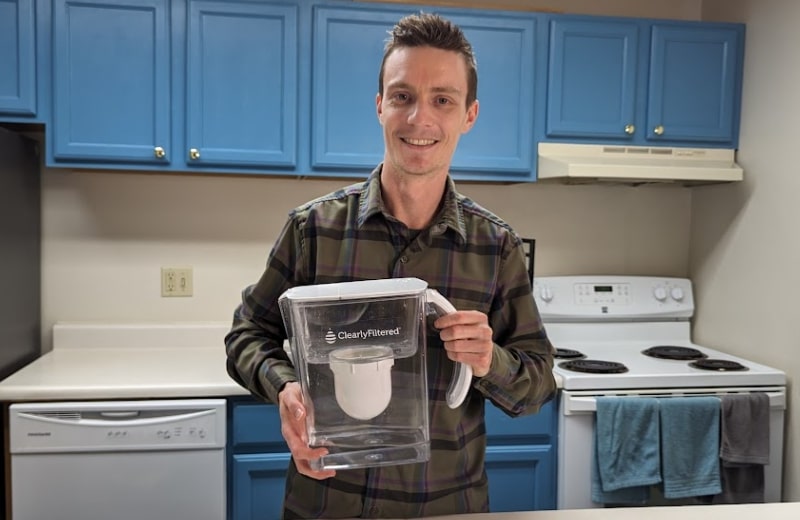
Certified PFAS Removal
The Clearly Filtered pitcher has been tested to reduce up to 99.5% PFAS – a very impressive figure. What we liked especially about the CF pitcher is that it has been third-party tested to remove 9 different forever chemicals, with removal percentages of between 95% and 99.5%. Most manufacturers only get their filters tested to remove PFOA and PFOS, with these being the most common PFAS chemicals, but we appreciate that Clearly Filtered arranged for additional testing to reassure us that the pitcher can protect against a range of forever chemicals that might be present in our water. The pitcher has also recently obtained a WQA certification to NSF/ANSI Standard 42, for the reduction of chlorine, taste, and odor, and NSF Standard 53, for the reduction of PFOA/PFOS – meaning that it’s one of the few water filter pitchers to be officially performance certified for PFAS reduction.
Alongside PFAS, the pitcher can also reduce hundreds of other contaminants, including 99.54% fluoride, 99.5% lead, 99.9% chlorine, as well as VOCs, chromium-6, pesticides, chloramine, disinfection byproducts, and more. Comparing the Clearly Filtered pitcher’s PFAS removal abilities with the abilities of other common pitchers we’ve tested, there’s simply no competition. Brita and PUR’s pitcher filters haven’t been tested for PFAS removal, while ZeroWater does remove PFAS – but it also removes healthy minerals from water.
Easy-To-Use Gravity Pitcher Filter
We much preferred the assembly process for the Clearly Filtered Pitcher compared to the SpringWell CF. There was no installation required – we just assembled the pitcher and used the included filter priming bag to efficiently prime the filter. Using the pitcher requires a bit more effort than the SpingWell CF because the pitcher is a standalone system that’s not connected to your water line. Rather than simply accessing filtered water from any faucet, we had to fill the jug with unfiltered water and keep it topped up throughout the day. Still, we wouldn’t call this hard work.
As a gravity filter, the CF pitcher has a slow and steady filtration process. We were happy to wait slightly longer for access to filtered water, knowing that our water was getting plenty of contact time with the filter media – exactly what’s needed for thorough contaminant removal.

Read the Full Review: Clearly Filtered Pitcher Review

AquaTru
The AquaTru is, based on our own testing, the best countertop reverse osmosis filter system for removing man-made chemicals like PFAs. This impressive water system is performance certified to remove up to 99.99% of contaminants, including PFAs.
Specs
| Price | $449.00+ |
| PFAs Removal | 99.9% |
| Contaminants Removed | 83+ |
| Certifications or Testing | NSF 42, 53, 58, 401 & P473 |
| Filter Life | 600 – 1,200 gallons |
| Annual Cost | ~$80 |
| Warranty | 1 year |
Here, we’ve reviewed the AquaTru Classic – AquaTru’s base model. You can also buy this unit in three upgrades:
- AquaTru Connect
- AquaTru Alkaline Classic
- AquaTru Alkaline Connect
The Connect has built-in WiFi and lets you view your water usage and filter status information on an app. The Alkaline Classic uses an alkaline remineralization filter instead of the standard VOC filter. The Alkaline Connect features both the WiFi connection and the alkaline remineralization filter. The price difference between the models is up to $70. The lifespan for the filters is 6-24 months, and we expect to spend around $80 annually on filter changes.
| AquaTru Configurations | Inclusions | Price |
|---|---|---|
| Classic | RO + VOC Filter | $449 |
| Connect | Wifi RO + VOC Filter | $499 |
| Alkaline Classic | RO + Alkaline Boost VOC Filter | $469 |
| Alkaline Connect | Wifi RO + Alkaline Boost VOC Filter | $519 |
Best For:
Anyone who prefers a portable PFAS removal solution with the thoroughness of the reverse osmosis filter process, without the fuss of under-sink installation.
What We Like:
- Performance certified for contaminant removal
- Eliminates the majority of TDS
- Only wastes 20% of water
- No-installation
What We Don’t Like:
- Quite expensive
- Remineralization costs extra
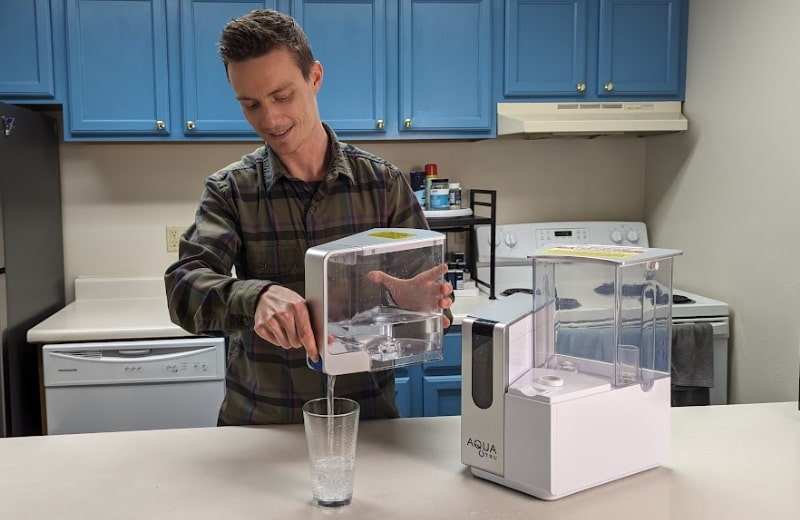
Certified Performance
We were initially drawn to the AquaTru RO system because it holds an IAMPO certification to NSF Standards for the removal of 83 contaminants, including 97.5% PFAS – minimum. We wanted to see how the system performed when removing contaminants from our own supply, and we found that it could remove 100% fluoride and lead, as well as 64% TDS.
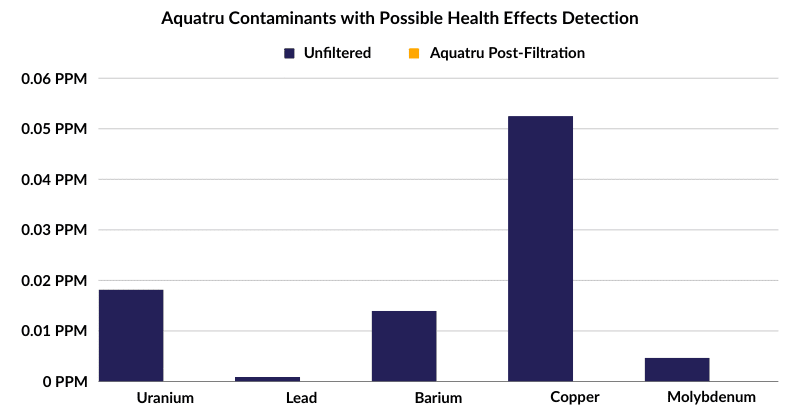
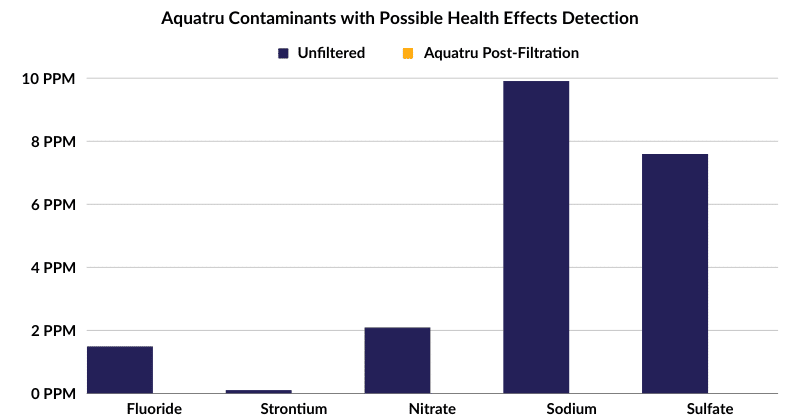
Again, our drinking water didn’t contain PFAS, so we’re keen to repeat this test with a water supply that does contain forever chemicals.
We’ve shared the results of our third-party laboratory testing for AquaTru in the table below.
| Contaminant | Measurement | Pre-Filtration | Post-Filtration | % Change |
|---|---|---|---|---|
| Barium | PPM | 0.014 | 0 | -100.00% |
| Calcium | PPM | 23.9 | 0.7 | -97.07% |
| Chloride | PPM | 9.2 | 0 | -100.00% |
| Copper | PPM | 0.0525 | 0 | -100.00% |
| Fluoride | PPM | 1.5 | 0 | -100.00% |
| Lead | PPM | 0.0009 | 0 | -100.00% |
| Magnesium | PPM | 6.08 | 0.36 | -94.08% |
| Molybdenum | PPM | 0.0047 | 0 | -100.00% |
| Nitrate (as N) | PPM | 2.1 | 0 | -100.00% |
| Phosphorus | PPM | 1.1 | 0 | -100.00% |
| Sodium | PPM | 9.91 | 0 | -100.00% |
| Strontium | PPM | 0.108 | 0 | -100.00% |
| Sulfate | PPM | 7.6 | 0 | -100.00% |
| Total Dissolved Solids | PPM | 112 | 12 | -89.29% |
| Uranium | PPM | 0.0182 | 0 | -100.00% |
| Zinc | PPM | 0.559 | 0 | -100.00% |
Although it seems a bit more technical on a first look, we found the AquaTru easy to use. Like with the Clearly Filtered pitcher, we had to fill the unit with water, and we could dispense purified water from the gravity tank at any time. Our only extra task was to empty the wastewater tank (something conventional filters like the CF pitcher don’t have). All reverse osmosis systems waste water – it’s one of their only downsides, in our opinion. But the AquaTru has a 4:1 efficiency ratio, meaning that, of the water we added to the system, only 1 gallon was wasted for every 4 gallons of purified water produced. That’s so much better than the conventional RO 1:4 efficiency ratio, which means that 4 gallons of water are wasted for every 1 gallon purified.
We appreciated having a digital display screen on the unit itself, which gave us helpful information about our water usage and filter lifespan. As for water delivery speed, the purification process itself is helped along by a pump, but the filtered water is dispensed into a tank. Water from the tank can then be dispensed via gravity, and we found that the dispensing speed would decrease as the tank emptied.
Read the Full Review: AquaTru Countertop Filter Review

Aquasana AQ-5300
The Aquasana AQ-5300 is our top under-sink filter unit for PFAS removal. This system uses a sediment filter, a catalytic carbon filter, and an ion exchange filter to treat kitchen faucet water, and has been WQA certified to NSF Standards to remove 77 impurities, including 95.2% PFAS.
Specs
| Price | $164.99 |
| PFAs Removal | 96% |
| Contaminants Removed | 77+ |
| Certifications or Testing | NSF 42, 53 & 401 |
| Filter Life | 600 gallons |
| Annual Cost | ~$130 |
| Warranty | 180 days |
The AQ-5300 has the advantage of being connected to your under-sink water line, so you get filtered water on demand whenever you turn on the faucet, and you don’t have the extra task of filling a water tank. Many of the under-sink filters we’ve tested have just one or two filter cartridges, but this Aquasana unit has three separate dedicated filter cartridges, each with a large media surface area, allowing for the most thorough contaminant removal.
At the time of our review, the unit was on sale at just under $175. Something important to note is that it comes with its own dedicated faucet, and we had the choice of three different faucets: brushed nickel, chrome, or oil-r\ubbed bronze (the price is the same regardless of the faucet style). There are performance benefits of the system using multiple filters, but it also made our estimated annual cost higher, at around $130 (assuming we’d replace them every 6 months or so).
Best For:
Anyone who wants the best on-demand POU filtered drinking water solution with an official performance certification for its ability to reduce PFAS.
What We Like:
- Removes 95%+ PFAS
- Multiple faucet styles to choose from
- WAQ certified for contaminant removal
- Three dedicated filter cartridges
What We Don’t Like:
- Needs to be installed
- Multiple filters to replace
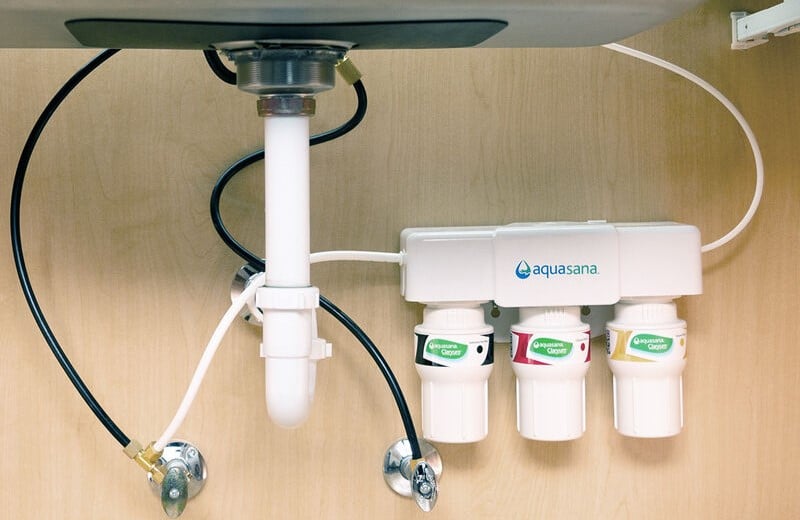
WQA Certified for PFAS Removal
While several of the under-sink water filtration systems we tested claimed to remove PFAS, the AQ-5300 was one of the select few that had been officially performance certified for its ability to do so. The unit has a WQA certification to NSF Standard 53 for its ability to remove contaminants with health effects, including PFOS and PFOA. According to the test data sheet for the AQ-5300, it can reduce these chemicals by up to 95.2%. Plus, it tackles 70+ other common contaminants that you’re likely to find alongside forever chemicals in your water, including chlorine, asbestos, lead, mercury, VOCs, BPA, pharmaceuticals, and cysts. As well as its WQA certification to NSF Standard 53, it’s also certified to Standards 42 and 401 for its performance. What makes the system so capable? We think it’s the combination of different filter stages used: there’s Aquasana’s Claryum® technology, alongside catalytic and granular activated carbon media, and a sediment pre-filter.
The AQ-5300 is connected to your under-sink water line, so it needs a slightly more complicated setup than the countertop PFAS filters we’ve reviewed. But it comes with all the components you need for the install and the process is relatively straightforward, so most folks will be able to do it themselves, or ask a friend or family member – no need to account for the cost of a plumber. The most challenging part of the installation is drilling a hole through your countertop, which you’ll need to do if you don’t have a hole you can use already (such as one for a soap dispenser).
As for flow rate, we would have liked to see this a little higher. 0.5 gallons per minute is fairly slow – the average kitchen faucet has a flow rate of between 1.0 and 2.2 GPM, so you’ll need more patience when you’re filling a glass. We could upgrade to the Max Flow version of the system for an extra $50, but even that only has a rated service flow of 0.72 GPM, so we don’t think it’s worth it. The good news is that the system is used with a separate faucet, so you can still get your usual flow of water from your other faucet for washing, cleaning, and non-drinking purposes.

Clearly Filtered Universal Inline Fridge Filter
Clearly Filtered has made our list twice, being one of the few brands to provide exceptional PFAS removal across multiple products. The Clearly Filtered Universal Inline Filter is a highly capable inline filter that removes up to 99.8% of PFAS, and is our top pick for the best refrigerator water filter for PFAS reduction.
Specs
| Price | $165 |
| PFAs Removal | 99.8% |
| Contaminants Removed | 232+ |
| Certifications or Testing | NSF 42, 53, 401 |
| Filter Life | 365 gallons |
| Annual Cost | – |
| Warranty | Lifetime |
The idea of the Clearly Filtered Universal Inline Fridge Filter is that it’s installed at the water line connecting your fridge to your water supply, so water gets filtered before it even reaches your fridge. The benefit of this is that you don’t have to make sure the filter fits inside your fridge, which is often a challenge due to the fact that many refrigerator manufacturers design their fridges so only their own filters can fit in the slots.
At the time of our review, the filter cost just under $150 – so it’s not cheap for an inline fridge filter. However, like Clearly Filtered’s other products, the Inline Fridge Filter can remove so many more contaminants than any similar fridge filter we’ve tested (232+ to be precise), so the price is certainly justified if you want to remove up to 9 types of PFAS and hundreds of other common contaminants. There’s just one filter in the system, which lasts up to 365 gallons (approximately 12 months), and when you replace the filter, you replace the whole thing. That means our projected annual spend was around $150.
Best For:
Anyone looking for the most thorough in-line filtration system that removes PFAS much more effectively than a standard granular activated carbon system, providing filtered fridge water and ice cubes.
What We Like:
- Independently tested to remove 9 types of PFAS
- Also removes 230+ other contaminants
- Can be installed regardless of your fridge model
- Long 12-month max. filter lifespan
What We Don’t Like:
- Expensive compared to similar systems
- No official performance certification
Removes up to 99.8% of 9 Types of PFAS
Once again, Clearly Filtered has gone the extra mile with its third-party testing for PFAS removal. The Universal Inline Filter has been tested to remove up to 99.62%-99.81% of 9 different types of forever chemicals: 8:2 Fluorotelomer sulfonate, perfluorobutane sulfonate, perfluorodecanoic acid, perfluorohexane sulfonate, perfluorohexanoic acid, perfluorononanoic acid, perfluorooctane sulfonate (PFOS), perfluorooctanoic acid (PFOA), and polytetrafluoroethylene. Plus, it removes hundreds more contaminants, including 90.65% fluoride, 94.27% arsenic, 99.34% lead, 16 types of herbicides, 52 types of pesticides, 22 pharmaceuticals, 62 VOCs, and more.
Given that most other fridge filters we’ve tested can remove chlorine and not much else, the Universal Inline Filter is doing a whole lot more than most of its competitors, and it’s the obvious choice for anyone looking to remove PFAS and as many other contaminants as possible from their fridge drinking water. Personally, we’d much rather spend our money on a costlier system that genuinely improves water safety than a cheaper system that simply makes our water taste better.
As an inline filter, this Clearly Filtered system connects to any¼-inch waterline and is intended to be used upstream of any water-based appliance, including your ice maker, fridge, or kitchen sink. We’ve read the installation instructions, and they’re pretty straightforward. You certainly don’t need a professional to install the system for you – simply shut off your water supply, make a cut in the flexible water line leading to your fridge, connect the filter’s inlet and outlet water lines, and you’re good to go. There’s a bracket included in the box if you want to mount the filter on the wall behind your fridge.

ProOne Big+ Gravity-Fed Water Filter
The ProOne Big+ is capable of removing up to 99.9% of PFAs, according to private testing, so it’s our top recommended countertop gravity filtration unit for this purpose. The Big+ holds up to 3 gallons of water and operates without a water pressure or pump, so it’s a great solution for folks who rent their homes or want a no-install filtration system with a decent water holding capacity.
Specs
| Price | 229.95+ |
| PFAs Removal | 99.9% |
| Contaminants Removed | 200+ |
| Certifications or Testing | NSF 42, 53, P231 |
| Filter Life | 1,000-1,200 gallons |
| Annual Cost | ~$100 |
| Warranty | 1 year |
The ProOne Big+ is a hefty unit with a 3-gallon capacity. It’s a standalone unit that’s intended to sit on a kitchen countertop, and it is quite bulky – it’s 9 inches wide and nearly 23 inches tall. We were able to test the Big+ at home, and our stainless steel unit was shipped with everything we needed for the assembly, including the stainless steel spigot and our initial filters.
There are a few different unit configurations to choose from. We went for the polished finish unit with two filters, and at the time of our review, it was around $290. That makes it pretty pricey, but we think it’s good value given its water storage capacity and its long filter lifespan of up to 18 months (it’s also a great deal cheaper than many similar units, like the Big Berkey). We expected to spend within $100 on filter changes, depending on how long ours lasted.
| ProOne Big+ Options | Price (Polished) | Price (Brushed) |
|---|---|---|
| 1 G2.07 Filter Element | $229.95 | $239.95 |
| 2 G2.07 Filter Element | $289.95 | $299.95 |
| 3 G2.09 Filter Element | $369.95 | $379.95 |
Best For:
Folks looking for a no-install, capable gravity-based countertop filtration system that filters big batches of PFAs-free drinking water.
What We Like:
- Removes 9 forever chemicals
- Also removes 200+ additional contaminants
- No install, portable filtration
- Long filter lifespan
What We Don’t Like:
- No performance certification
- Bulky design

Tested to Remove 99.9% of 9 Types of PFAS
Of all the filters we tested for PFAS removal, the ProOne Big+ was one of the best, performance-wise. It rivals the Clearly Filtered Pitcher, with a long list of contaminants removed, and we felt that it effectively addressed all our water quality concerns. Like the CF pitcher, ProOne has gone the extra mile with third-party testing – the Big+ has been tested to remove up to 99.9% of 9 types of PFAS chemicals: PFBS, PFDA, PFHxA, PFNA, PFOA, PFOS, PFSxS, PTFE, and PTOH. Testing has been conducted by a private laboratory to NSF Standards 42, 53, and P231l. You can view the test results here.
Some of the other contaminants reduced or removed by the Big+ include lead, VOCs, chlorine, chloramine, pesticides, and herbicides – plus the more difficult-to-remove contaminants, like pharmaceuticals, fluoride, and bacteria.
We tested the ProOne Big+ on our own water supply in Steamboat Springs, CO. It did a great job of removing manganese, copper, fluoride, lead, and aluminum, removing 100% of these contaminants.
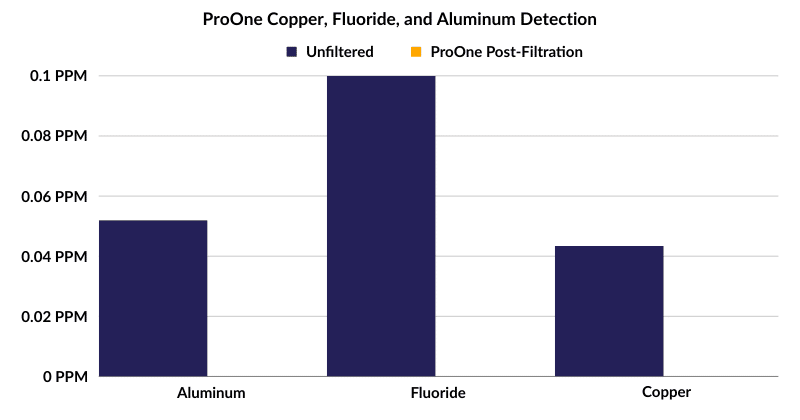
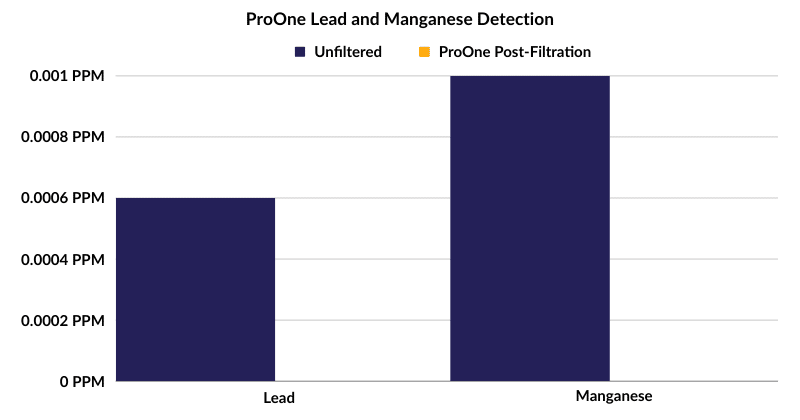
Again, we plan to test the unit’s ability to specifically filter PFAS from a water source, and we’ll update this review when we do. We’d prefer that the Big+ had an official performance certification, but it’s only NSF 42 certified for its component quality, which has no ties to performance.
Here’s a summary of the ProOne system’s performance as evaluated through our third-party laboratory analysis.
| Contaminant | Measurement | Priming Water | Test 1 Pre-Filtration | Test 1 Post-Filtration | % Reduction | Test 2 Pre-Filtration | Test 2 Post-Filtration | % Reduction |
|---|---|---|---|---|---|---|---|---|
| Aluminum | PPM | ND | 0.052 | 0 | -100.00% | 0.03 | 0 | -100.00% |
| Barium | PPM | 0.0265 | 0.0127 | 0.0275 | 116.54% | ND | ND | ND |
| Bromodichloromethane | PPB | 0.00289 | 0 | 0.00319 | n/a | ND | ND | ND |
| Calcium | PPM | 35.1 | 8.8 | 19.3 | 119.32% | ND | ND | ND |
| Chloride | PPM | 14.4 | 6.9 | 8.3 | 20.29% | ND | ND | ND |
| Chloroform | PPB | 0.0141 | 0.0352 | 0.0155 | -55.97% | ND | ND | ND |
| Cobalt | PPM | 0.0013 | ND | ND | ND | ND | ND | ND |
| Copper | PPM | 0.0424 | 0.0434 | 0 | -100.00% | ND | ND | ND |
| E. coli | CFU/100ml | ND | ND | ND | ND | 15 | 0 | -100.00% |
| Enterococcus | CFU/100ml | ND | ND | ND | ND | 4 | 0 | -100.00% |
| Fluoride | PPM | 0.1 | 0.1 | 0 | -100.00% | ND | ND | ND |
| Iron | PPM | ND | ND | ND | ND | 0.1 | 0.02 | -80.00% |
| Lead | PPM | 0.0009 | 0.0006 | 0 | -100.00% | ND | ND | ND |
| Magnesium | PPM | 10.6 | 2.19 | 7.91 | 261.19% | ND | ND | ND |
| Manganese | PPM | ND | 0.001 | 0 | -100.00% | 0.02 | 0 | -100.00% |
| Phosphorus | PPM | ND | ND | ND | ND | 0.01 | 0.21 | 2000.00% |
| Potassium | PPM | 1.91 | 0 | 1.27 | n/a | ND | ND | ND |
| Sodium | PPM | 12.5 | 10.4 | 14.2 | 36.54% | ND | ND | ND |
| Strontium | PPM | 0.193 | 0.062 | 0.098 | 58.06% | ND | ND | ND |
| Sulfate | PPM | 24.1 | 10 | 16.9 | 69.00% | 42.29 | 27.4 | -35.21% |
| Total Coliform | CFU/100ml | ND | ND | ND | ND | 75 | 0 | -100.00% |
| Total THMs | PPB | 0.01699 | 0.0352 | 0.01869 | -46.90% | ND | ND | ND |
As with the Clearly Filtered pitcher, and any other gravity system, we knew we’d be waiting longer for filtered water. On average our unit with two 7-inch G2.0 filters had a flow rate of around 0.5 gallons per hour – you might have a faster or slower flow rate depending on the number of filters you use and your water quality. One advantage the Big+ had over the Clearly Filtered pitcher was that we didn’t have to refill it anywhere near as often because of its large water holding capacity.
Read the Full Review: ProOne Big+ Water Filter Review
📚 Methodology: How We Tested The Best Water Filters For Removing PFAS
When researching and testing products for this guide, we focused solely on water treatment systems that are designed to reduce PFAS contamination.
Here are some of the factors we considered when comparing, reviewing, and ranking the filters on our list.
- PFOA and PFOS removal capability – First and foremost, since we were specifically looking for a drinking water filter that reduces PFAs chemicals, our top priority was that our selected filters should achieve this to an exceptional standard. The greater the filter’s PFAS removal ability, the better. We prioritized water filters that were capable of removing at least 90% PFAs, preferably up to 99% and beyond.
- Other contaminants present – While our main goal was to remove PFAS, we knew it wasn’t the only contamination issue in our tap water. Most of the water filters we reviewed were capable of removing a range of contaminants, including other common impurities, like lead, chlorine, and other chemicals and heavy metals. If you don’t know much about your water quality, we recommend reviewing your most recent water quality report or paying for a private testing package from a laboratory.
- Filtration method – We identified a range of different filter types, each offering unique methods of filtration, for PFAS removal. These included whole-home filters, under-sink filters, countertop filters, reverse osmosis systems, water distillers, and refrigerator filters. We wanted to share solutions for different situations and preferences – for instance, no-install countertop units for folks in rentals, and whole-home systems for people wanting to remove toxic PFAS from their entire water supply. With this in mind, we reviewed several filters across each category, shortlisting the best across the board.
- Testing & certifications – We were able to test most PFAS filters in our own homes, but a roadblock for us was that our water supply didn’t contain these chemicals, so we couldn’t personally test their PFAS removal abilities. For that reason, it was particularly important to us that our shortlisted filters had third-party testing or official performance certifications for this purpose. NSF/ANSI 53, for contaminants with health effects, and NSF/ANSI 58, for reverse osmosis drinking water filters, are the main certifications that can be obtained for PFAS removal. (P.S: You might see a few filters that have an NSF P473 certification for PFOA & PFOS removal. This Standard has now been replaced by NSF 53 or 58 for PFAS removal).
- Flow rate – Whether we were reviewing a gravity-based countertop system or an inline system connected to a water pipe, flow rate was an important ranking consideration. While our priority wasn’t to look for the fastest-flow filter at the expense of all other features, we still ensured that the systems we reviewed could be relied upon to provide a steady supply of filtered water, as intended by the manufacturer. Flow rate was a key consideration for the under-sink and whole-home systems we tested, since an underperforming system in this respect could result in a disruption to the water supply.
- Customer feedback – While the information shared in our reviews was based on our own insight, we only had a limited testing period, and we knew that our own experience wasn’t necessarily reflective of the overall customer experience. To determine how our shortlisted PFAS filters performed with everyday use, we scoured hundreds of customer reviews. This helped us to narrow down our focus to products that were consistently praised by hundreds of satisfied customers.
- System quality – We’ve tested enough water filters in our time to know that the quality of the components in a filtration system determines every aspect of performance, including its reliability and lifespan. We focused on PFAS filters that looked, felt, and acted the part. Reviewing customer feedback helped us to get a better understanding of a filter’s long-term performance and durability with everyday use.
- Value for money – We found that different filters for PFAS removal had different costs to consider. For instance, some of the systems we reviewed had multiple filters to change, while others had only a single filter. Some systems had longer filter lifespans than others. Some cost hundreds of dollars to purchase, while others cost less than $50. Rather than finding the cheapest products, we chose the filters on this list for the value for money they offered, based on their ability to remove PFOA and PFOS, their construction quality and durability, and their reliability.
- Filter capacity – When reviewing and shortlisting the best filter for removing forever chemicals, we also wanted to take into account filter capacity, or how long the filter would last before it needed to be replaced. We knew that different situations would result in different preferences in this category – family size, daily water usage, and maintenance preferences should all be considered when you’re choosing between different filter capacities. On average, the filters that we reviewed had 4-12-month lifespans and needed between 1 and 3 filter changes per year.
- Installation & maintenance – All the water filters for PFAS that we tested needed some level of installation and maintenance, but we noted that some filters were much easier to install and maintain than others. We found that portable filters, like pitcher filters, could be assembled in a matter of minutes, and we identified that they were best for folks looking for a no-install solution. Whole house systems and under-sink systems typically required a more complicated installation, but we found them easier to use post-installation because we didn’t have to manually fill them with water ourselves. We selected systems that were easy to maintain, with simple cleaning and filter changes, but our advice is to make sure you’re willing to commit to a filter’s maintenance requirements before spending your money.
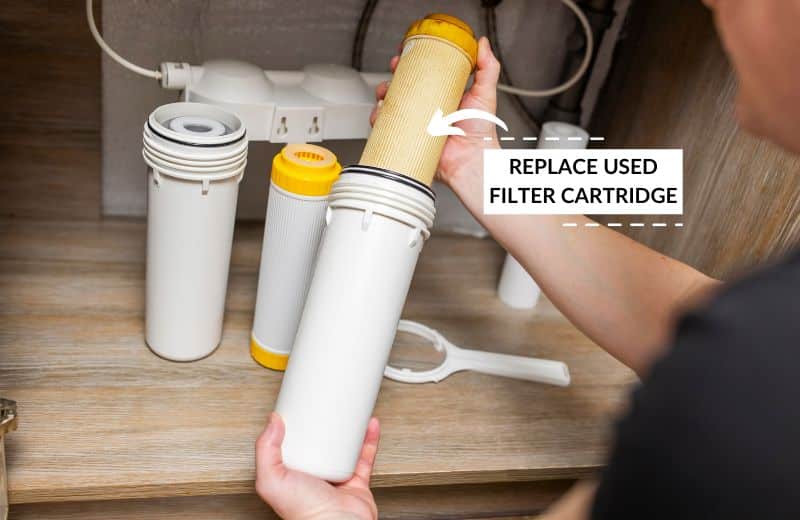
❔ Frequently Asked Questions
What water filter will remove PFAS?
The best water filters for removing PFAS are reverse osmosis systems, some carbon filters, and water distillers. If you want to be certain that a filter can remove PFAS from your drinking water, look for third-party testing as proof – or, even better, an official NSF certification.
Do water filters filter out PFAS?
Not all water filters are guaranteed to reduce PFAS levels, so shop around and read guides like this one to invest wisely in the best filter for removing PFAS. Unless a water filter has proof of testing for its ability to remove forever chemicals, assume that it can’t.
Does Brita water filter remove PFAS?
No, Brita filters aren’t designed to filter PFAS. These filters can only remove a small selection of contaminants, namely those that affect water’s taste and smell.
Does the Zero Water filter remove PFAS?
Yes, the Zero Water pitcher is advertised to remove PFAS, but this filter isn’t quite as capable as the Clearly Filtered pitcher, so it didn’t make our list.
Does distilling water remove PFAs?
Yes. Up to 99% of PFAS are removed by distilling water. However, distillation is an incredibly lengthy process, so we didn’t include any distillers in this guide.
Do reverse osmosis filters remove PFAS?
Yes, a reverse osmosis filter can remove almost 100% of PFAs.
Can granular activated carbon filters remove PFAS?
It depends. Some activated carbon filters remove virtually all PFAS from drinking water. However, some types of activated carbon filters don’t reduce PFAS at all.
Does bottled water have PFAS?
Yes, PFAS have been found in bottled water, so you’re not necessarily safer if you exclusively drink bottled water rather than tap water.
Does boiling water reduce PFAS?
No. Boiling water will only cause some of the water to evaporate, increasing the concentration of toxic substances compared to the volume of water.
🤓 About Our Experts
This guide was produced by Brian Campbell, WaterFilterGuru.com’s Founder and Water Filter Specialist, who researched, reviewed, and tested our shortlisted products. You can learn more about Brian in the author bio below.

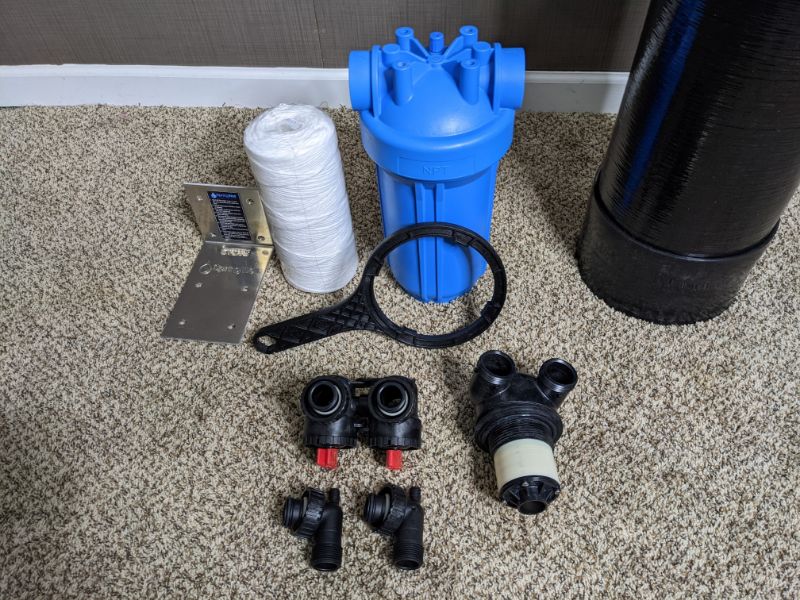
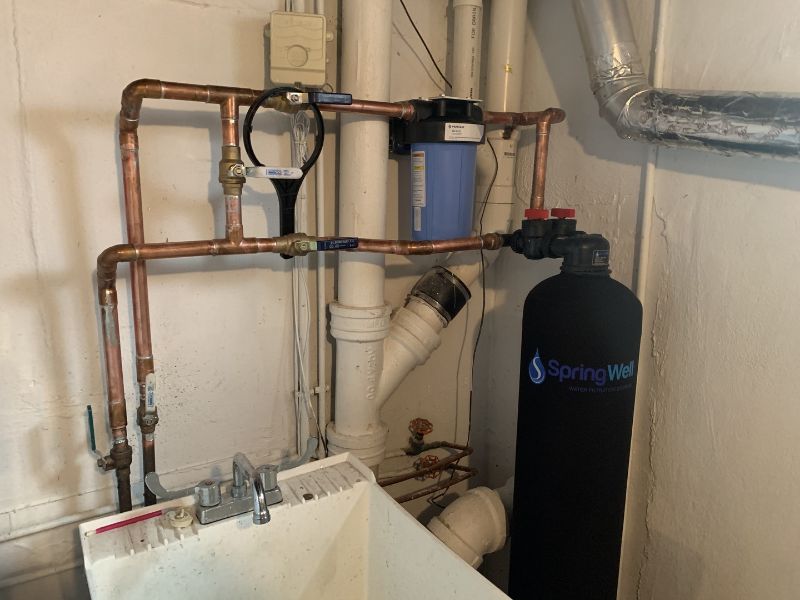
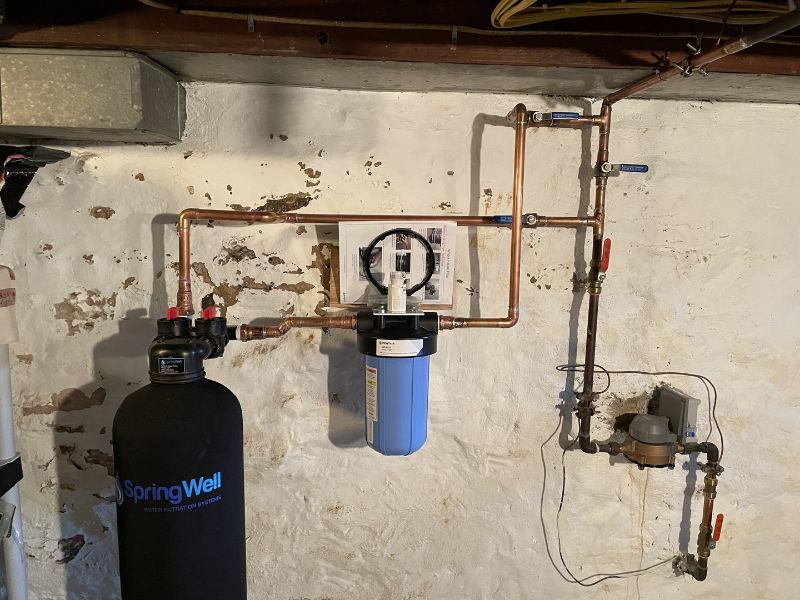
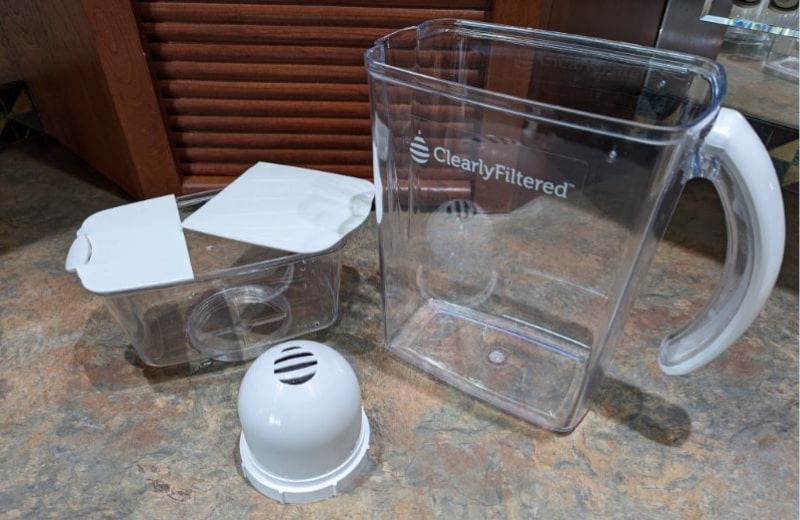
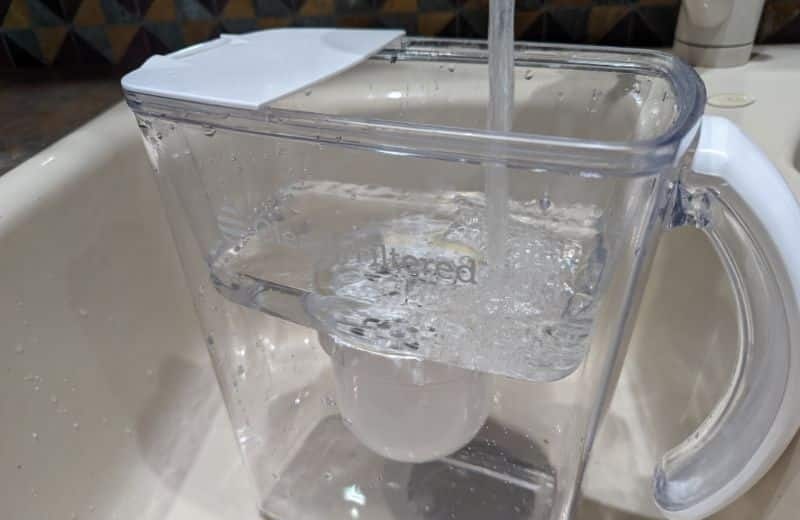
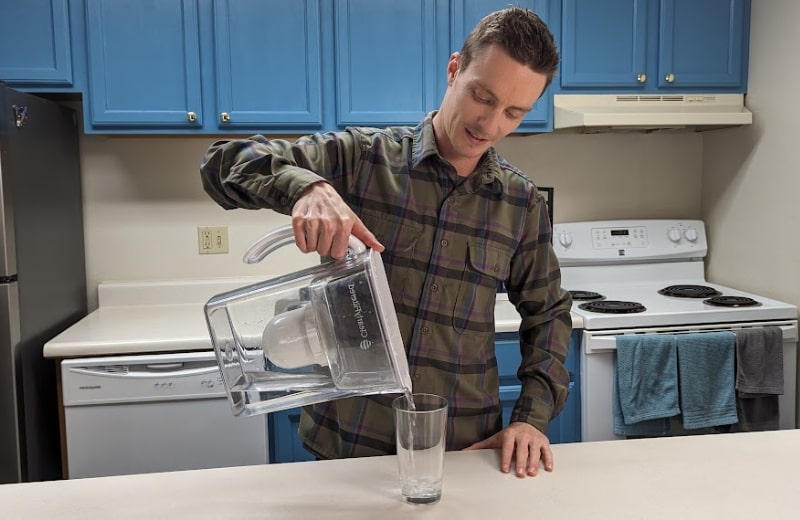

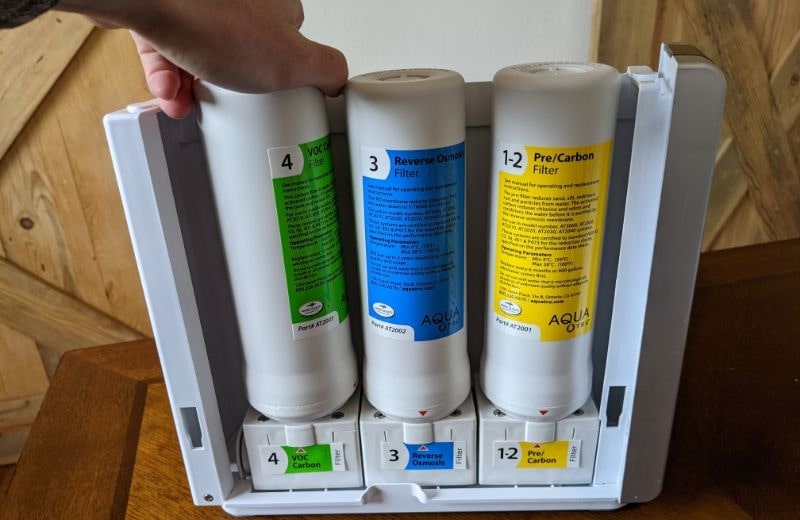
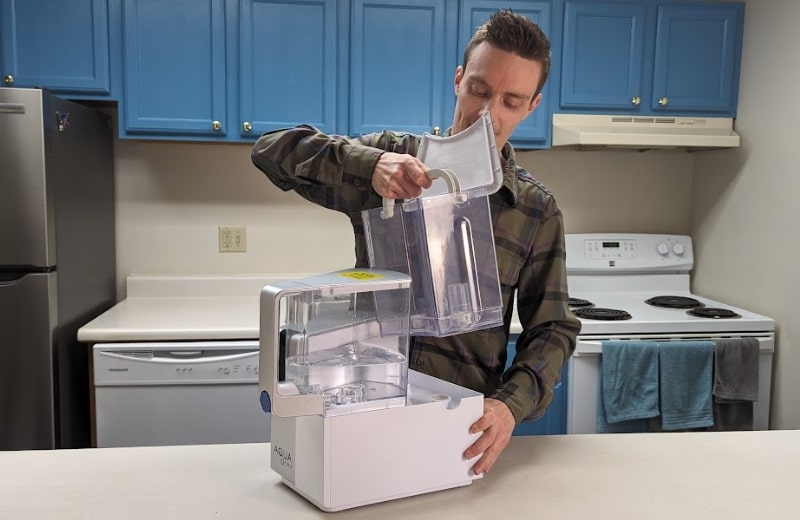
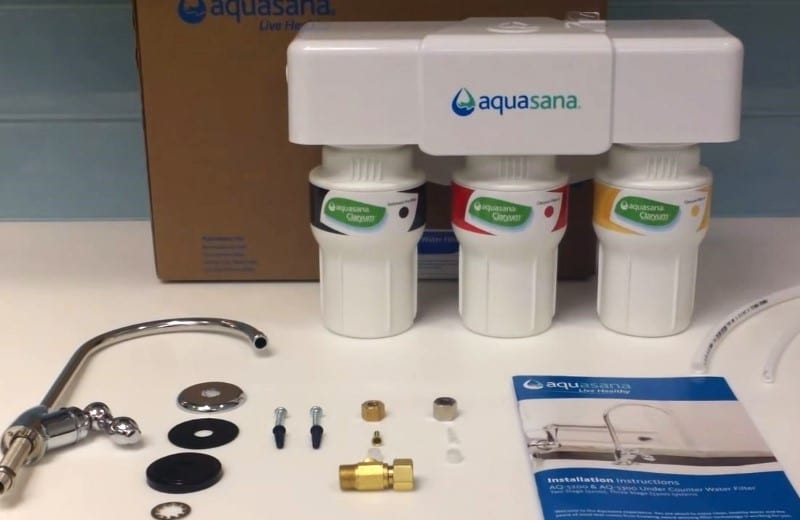
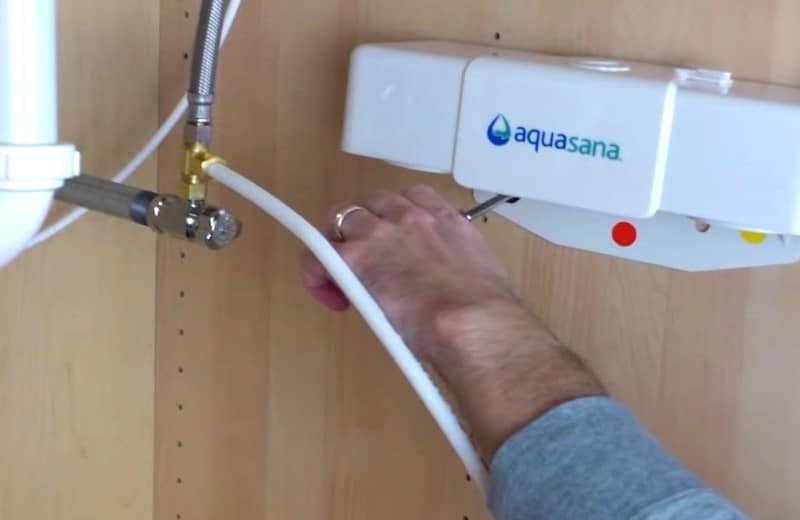
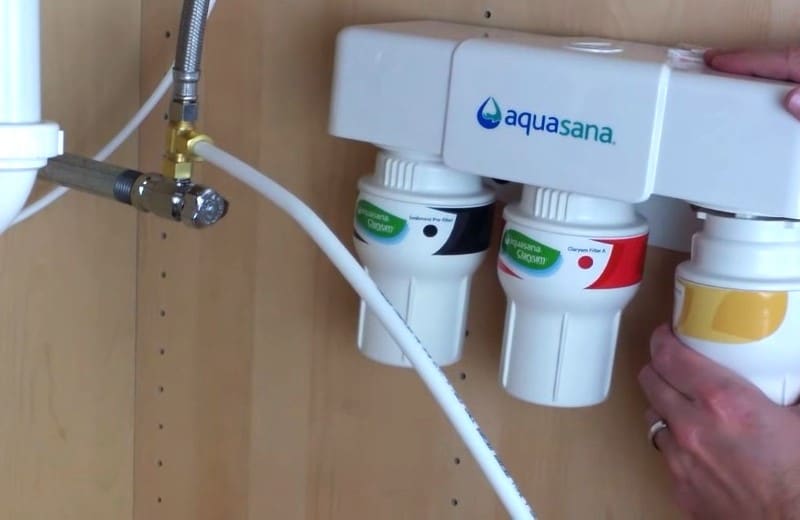
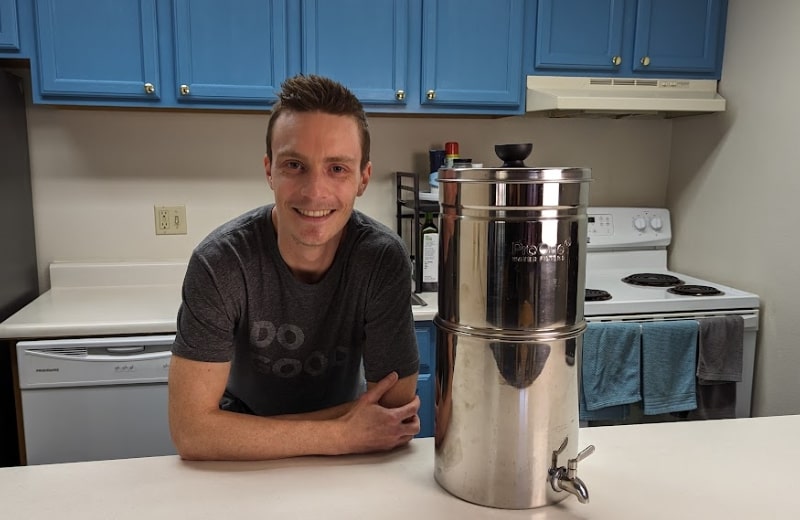
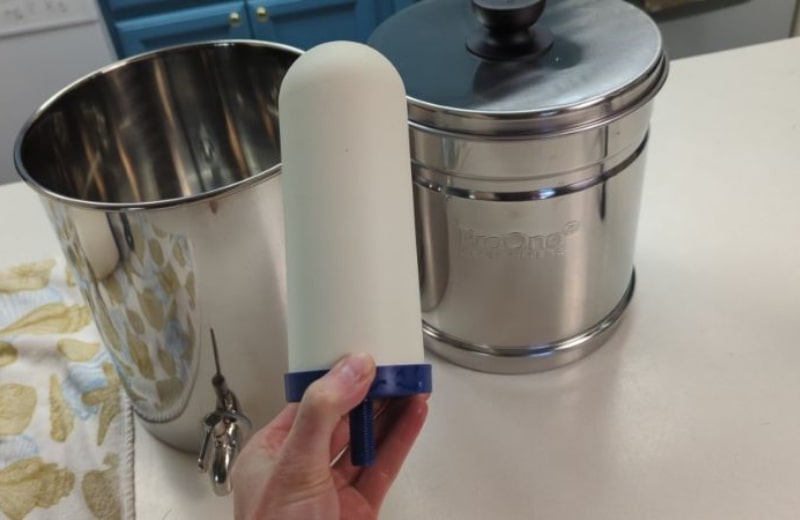
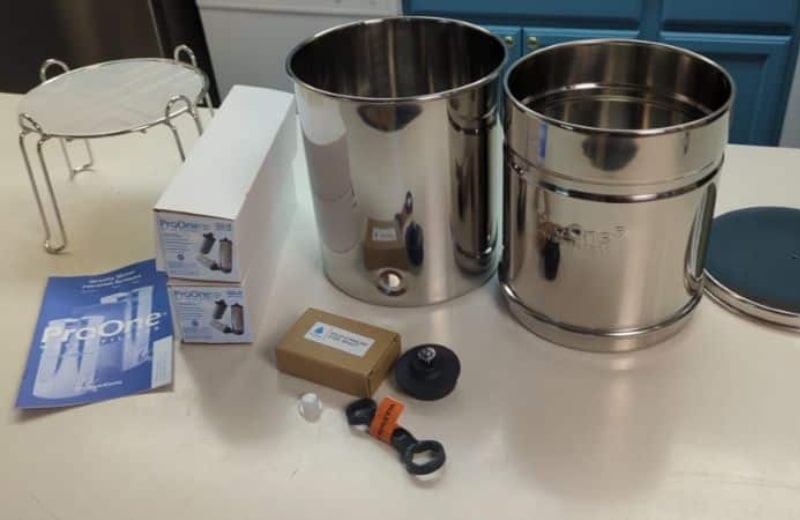

Hello- I would like to know if this is better for our body than drinking distilled water?
If what is better than drinking distilled water?